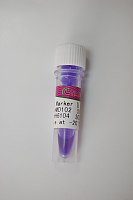DNA Transposons for Modification of Human Primary T Lymphocytes
互联网
818
Genetic modification of peripheral blood T lymphocytes (PBL) or hematopoietic stem cells (HSC) has been shown to be promising in the treatment of cancer (Nat Rev Cancer 3:35–45, 2003), transplant complications (Curr Opin Hematol 5:478–482, 1998), viral infections (Science 285:546–551, 1999), and immunodeficiencies (Nat Rev Immunol 2:615–621, 2002). There are also significant implications for the study of T cell biology (J Exp Med 191:2031–2037, 2000). Currently, there are three types of vectors that are commonly used for introducing genes into human primary T cells: oncoretroviral vectors, lentiviral vectors, and naked DNA. Oncoretroviral vectors transduce and integrate only in dividing cells. However, it has been shown that extended ex vivo culture, required by oncoretroviral-mediated gene transfer, may alter the biologic properties of T cells (Nat Med 4:775–780, 1998; Int Immunol 9:1073– 1083, 1997; Hum Gene Ther 11:1151–1164, 2001; Blood 15:1165–1173, 2002; Proc Natl Acad Sci U S A, 1994). HIV-1-derived lentiviral vectors have been shown to transduce a variety of slowly dividing or nondividing cells, including unstimulated T lymphocytes (Blood 96:1309–1316, 2000; Gene Ther 7:596–604, 2000; Blood 101:2167–2174, 2002; Hum Gene Ther 14:1089–1105, 2003). However, achieving effective gene transfer and expression using lentivirus vectors can be complex, and there is at least a perceived risk associated with clinical application of a vector based on a human pathogen (i.e., HIV-1). Recently it has been found that oncoretroviral and lentiviral vectors show a preference for integration into regulatory sequences and active genes, respectively (Cell 110:521–529, 2002; Science 300:1749–1751, 2003). Additionally, insertional mutagenesis has become a serious concern, after several patients treated with an oncoretroviral vector for X-linked SCID developed a leukemia-like syndrome associated with activation of the LMO2 oncogene (Science 302:415–419, 2003). Naked DNA-based genetic engineering of human T lymphocytes also requires T cells to be activated prior to gene transfer (Mol Ther 1:49–55, 2000; Blood 101:1637–1644, 2003; Blood 107:2643–2652, 2006). In addition, random integration by electroporation is of low efficiency. We have recently reported that the Sleeping Beauty transposon system can efficiently mediate stable transgene expression in human primary T cells without prior T cell activation (Blood 107:483–491, 2006). This chapter describes methodology for the introduction of SB transposons into human T cell cultures with subsequent integration and stable long-term expression at noticeably high efficiency for a nonviral gene transfer system.







